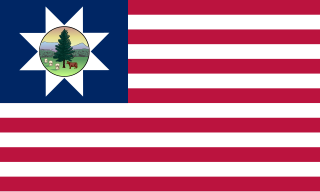
The 11th Vermont Infantry Regiment was a three-years infantry regiment in the Union Army during the American Civil War. It served in eastern theater, from September 1862 to August 1865. It served in the XXII Corps in the defenses of Washington D.C., and with the Vermont Brigade in VI Corps. The regiment was mustered into United States service on September 1, 1862, at Brattleboro, Vermont. On December 10, 1862, its designation changed to the 1st Vermont Heavy Artillery.
1st Ohio Heavy Artillery Regiment was an artillery regiment that served in the Union Army during the American Civil War.
Battery H, 5th U.S. Artillery was United States Regular Army artillery company that served in the Union Army during the American Civil War.
The 174th Ohio Infantry Regiment, sometimes 174th Ohio Volunteer Infantry was an infantry regiment in the Union Army during the American Civil War.
The 178th Ohio Infantry Regiment, sometimes 178th Ohio Volunteer Infantry was an infantry regiment in the Union Army during the American Civil War.

The 150th Ohio Infantry Regiment, sometimes 150th Ohio Volunteer Infantry was an infantry regiment in the Union Army during the American Civil War.

The 3rd Rhode Island Infantry Regiment was an infantry regiment in the Union Army during the American Civil War.

The 5th Rhode Island Infantry Regiment was an infantry regiment in the Union Army during the American Civil War.
Battery E, 1st Rhode Island Light Artillery Regiment was an artillery battery that served in the Union Army during the American Civil War.
Battery F, 1st Rhode Island Light Artillery Regiment was an artillery battery that served in the Union Army during the American Civil War. The battery briefly served as cavalry, March 20 to May 18, 1862.
Battery H, 1st Rhode Island Light Artillery Regiment was an artillery battery that served in the Union Army during the American Civil War.
The 11th United States Colored Heavy Artillery Regiment, previously designated the 14th Rhode Island Heavy Artillery Regiment (Colored), was an African American artillery regiment that served in the Union Army during the American Civil War.
16th Indiana Battery Light Artillery was an artillery battery that served in the Union Army during the American Civil War.
The 22nd Indiana Battery Light Artillery was an artillery battery that served in the Union Army during the American Civil War.
23rd Indiana Battery Light Artillery was an artillery battery that served in the Union Army during the American Civil War.
The 4th Connecticut Infantry Regiment was an infantry regiment that served in the Union Army during the American Civil War.

1st Connecticut Heavy Artillery Regiment was an artillery regiment that served in the Union Army during the American Civil War.
The 85th Regiment Pennsylvania Volunteer Infantry was an infantry regiment that served in the Union Army during the American Civil War.

The 5th Massachusetts Battery was an artillery battery that served in the Union army during the American Civil War. It was one of the Massachusetts regiments organized in response to President Abraham Lincoln's call on May 2, 1861 for volunteer troops to serve a term of three-years. The battery trained at Camp Shouler in Lynnfield, Massachusetts and Camp Massasoit in Readville, Massachusetts. It departed Boston by steamship on December 25, 1861.

Battery K, 1st Missouri Light Artillery Regiment was an artillery battery unit from Missouri that served in the Union Army during the American Civil War. The 1st Missouri Light Artillery Regiment was formed 1 September 1861. Battery K fought at Fort Henry, Fort Donelson, Shiloh, 1st Corinth, and 2nd Corinth in 1862. The unit was in action at Helena and Bayou Fourche in 1863. Battery K performed garrison and occupation duty at Little Rock, Arkansas in 1863–1865 before being mustered out on 4 August 1865.





